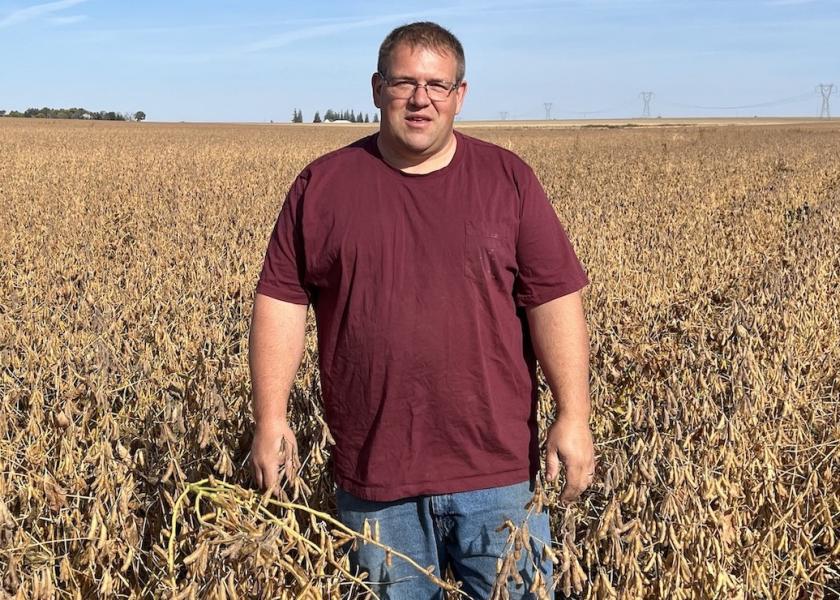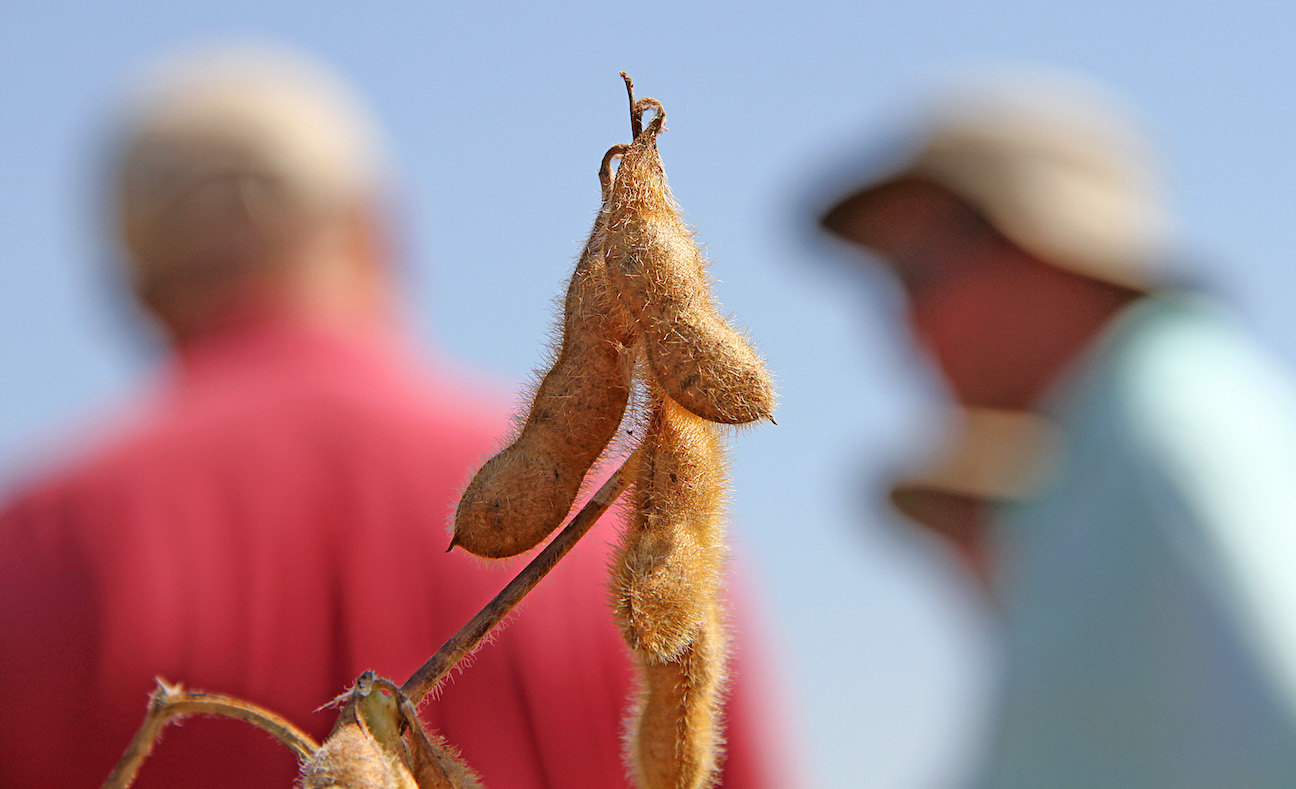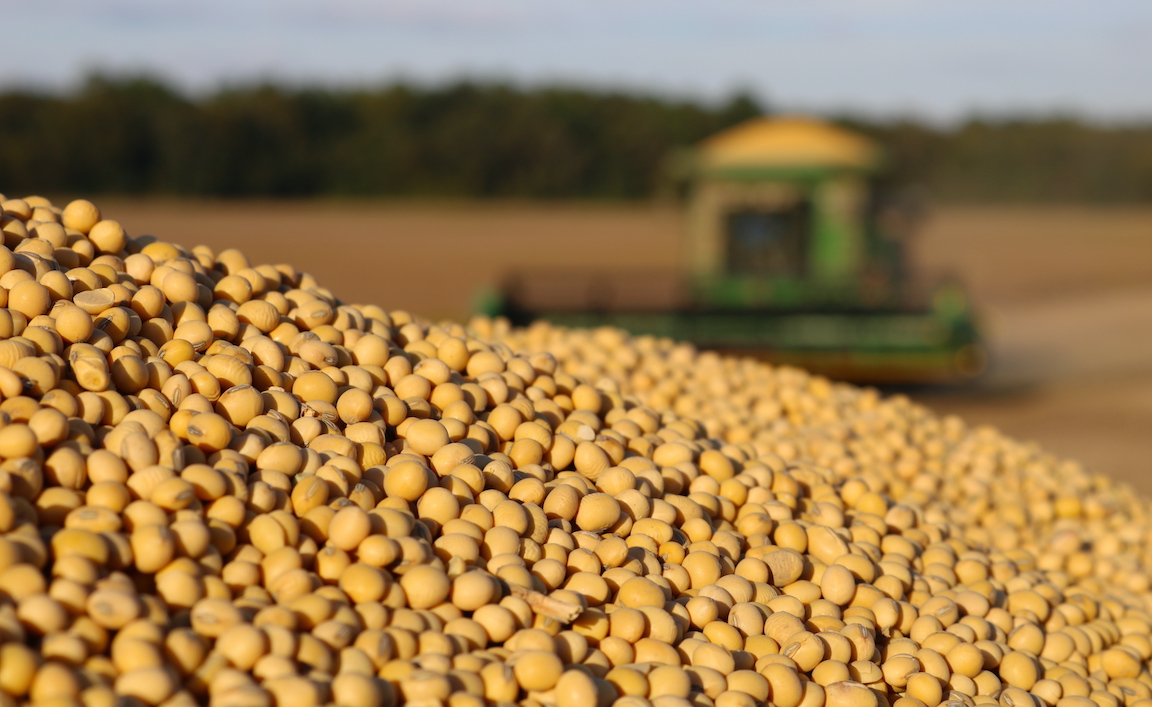Iowa Farmer Goes Bushels Up and Fertilizer Down with Biologicals

Matt Brincks’ Iowa farm is home to an eye-popping see-saw. In the past decade, his average yields have climbed 30 bushels in corn and 12 bushels in soybeans—all while his fertilizer use has dipped by half in nitrogen and two-thirds in phosphorus and potassium.
In 2012, Brincks went whole-hog, shifting his entire operation to biologicals. The result? “The effect has been incredible,” he says. “Fertilizer reduction, yield increases, soil structure improvement, and much more—I’ve seen serious changes. I’m an open book and the math doesn’t lie about what I’ve experienced on my farm.”
Fertilizer Bombs
No talk-radio chatter. No music blaring. No podcasts playing. Silence. Every day, inside the cab of a tractor, truck, or combine, third-generation producer Brincks, 42, rides alone with his thoughts, incessantly picking apart and reassembling the riddles from his rows.
Each night, bedtime follows suit, as a flood of brainstorms chase away the sandman. “I can’t stop thinking about my soil,” he explains. “Anybody who really realizes what has happened on my ground understands my obsession. Yes, I’m obsessed—but for good reason.”
On 1,100 acres outside Fredericksburg, in the Hawkeye State’s northeast corner, Brincks grows dryland corn and soybeans on gentle rolling ground—a topography in the medium between tabletop and hilly. At the edge of glacial advance, where the ice dozers dumped rock and fertile dirt, Brincks’ Chickasaw County farmland features a foot of topsoil atop a primarily clay base.
During his middle school years, Brincks worked on the farm of his science teacher, Dean Mohling. Several years later, Mohling suffered a back injury, and Brincks, a high school junior, planted and cut Mohling’s crop, soaking up chemistry lessons in the process and getting a full-time toehold in farming. (Brincks rents Mohling’s ground today.)
“Being a science teacher, Dean was really into soil life, and I picked the interest up,” Brincks describes. “At the time, in the 1990s, we started dabbling with plant biologicals, trying to stimulate growth with mycorrhizae. Biologicals were considered snake oil, so I didn’t tell any of my neighbors. Frankly, people thought you were flat-out crazy if you tinkered with biologicals, but then again, I was never afraid to try anything different. I kept researching, reading, and trying different products, all with a goal to stimulate my soils.”
In the early 2000s, as general agriculture industry interest expanded to variable rate, learning blocks, and management zones, Brincks launched fertilizer trials on 1-acre plots, applying nutrient amounts far below and above typical 300 lb. rates—sometimes bombing a spot with 1,200 lb. per acre. The outcomes left him grasping for answers: “Like almost everyone else, I was spending a ton on fertilizer, but in those learning blocks, I kept doing just as well on low rates or even no fertilizer at all. Sometimes, the places with heavy fertilizer had lower yields.”
“I was at a point where land prices had gotten insane and I knew I’d have to make do with close to the relatively small acreage I had. I wanted to take care of that ground even better and do everything to turn out every penny of profit. Meanwhile, I knew there was so much happening under my feet that I wasn’t aware of and my interest sparked like never before. What was going on that I couldn’t see, and why?”
“I Never Stopped”
By decade’s end, Brincks bought and tried a chain of off-the-shelf biological products—to no consistent satisfaction. “I was looking for a better sugar and carbon energy source to feed biological bugs, but I was trying to thread the needle by taking a piece of every biological company in the market.”
Brincks notes the fallacy of his former logic: “The best way to describe my mess is to visit an auto parts store. You walk in and see so many products to improve your mileage by 3%-5%. The products may be all legit, but you can’t buy them all and stack them to automatically get 100% better milage. Biological products are the same way, but when you find the right balance, it’s a game-changer.”
In 2013, Brincks heard a proposition from Biovante CEO Chris Masters, who offered growers a three-year trial: One field split between conventional management and Masters’ biological system.
Brincks snatched the proposal, and then some. “I approached Chris and told him, ‘No split. I want to go all in with my whole farm, as in every single acre.’ That was supposed to be a three-year deal, but I never stopped.”
No Sweat
Step by step. Methodical. Patterned.
“I never threw on a single biological product hoping for instant results,” Brincks emphasizes.
“Those first three years I saw slow, but definite improvements in yield. After three years, I could also tell the soil was changing, and by years four and five, the changes started to get big and bigger—very evident and undeniable.”
What were the “changes,” according to Brincks?

Soil aggregation and texture loosened to the point that Brincks backed into no till. “The soil composition began changing and I got rid of my tillage equipment because I didn’t need it. I never set out to be no till by using biologicals—it was just a cost-saving side effect for me.”
Fertilizer usage dropped dramatically, Brincks says, moving from roughly 1.2 units of nitrogen per bushel to .5-.6 units of nitrogen per bushel. “I’m now at about half the standard in nitrogen and two-thirds for potassium and phosphorus. Even when fertilizer prices started getting so high in 2021, it was no sweat for me, because I just don’t use that much.”
Yields initially improved in small increments, but by years four, five, and six, bushels showed significant increases, moving toward a 30-bushel climb in corn and a 12-bushel rise in soybeans. “My yield goal now in corn is 300 or the upper 200s on my good ground, and 200-225 on my poorest ground. My soybeans, over the last four years, have averaged 70 and are rising about 2 bushels per year. My goal is to get to 80 across the farm and I’m not there yet, but it’s coming.”
“Great Math”
What type of biologicals have spurred the changes on Brincks’ farm? “Over the past decade, Chris (Masters) helped me to sort through the clutter that is the biological industry,” Brincks adds. “He helped me get where I’m at by narrowing down what products and practices could improve my soil.”
Each spring, the first soil amendment deployed by Brincks is BioRed, a blend of aerobic and anaerobic microorganisms that “break down soil and provide energy.” Throughout every crop season, Brincks applies BioMate, a liquid containing two bacteria strains and four sugars: “I put it on with every pass, whether I’m planting, sidedressing, or spraying. If I go across a field, I’m putting out an energy source for plants and a food supply for the microorganisms.”
As Brincks’ comfort level with biologicals expanded, he moved into fulvic and humic applications. “I’ll go with mycorrhizae fungi products like BioFlex to put in-furrow at planting to help the rootzone and get started. I’d describe what I’m doing as an overall biologicals approach with seed, soil, plant, and energy.”
How does Brincks determine fertilizer needs? Brincks soil tests at a rapid rate during the season, often weekly, along with weekly tissue tests. “I don’t fix things in-season, but I use the numbers for the next year. I probably conduct more in-season testing than anyone I know, but it’s because I want to know exactly what my soil biology is giving the plants.”
“In soybeans, for example, I only add micronutrient fertilizer. In late season, I might foliar a shot of potash at R3 or maybe another pass with fungicide or liquid potassium acetate, but that’s it.”
How does the overall math of biologicals work on Brincks’ operation? Essentially, he is switching synthetic fertilizer expenditures to biologicals. “A biological product on its own isn’t terribly expensive, but as a whole program, it certainly adds dollars. But I’m moving fertilizer costs to biologicals, so I spend less than what I do for fertilizer at about 80 cents to the dollar. Therefore, it doesn’t cost me a penny more and meanwhile I’m building soil and plant health,” he says. “That is money spent far wiser in my opinion, and it’s great math for my operation.”
As in Life, As in Farming
A decade back, when Brincks first began a whole-operation change, he was sometimes a recipient of derision from fellow farmers. No more. The reactions have moved from scorn to skepticism to curiosity to participation, he explains: “First it was guys openly asking me questions and then it was lots of guys doing biologicals in my own area, and I’m not just talking about small-acreage farmers, but there are some 10,000-acre farms starting my geography.”
No matter his level of success, Brincks insists credit belongs to his wife, Janette, and father, Gene.
“There are so many people that helped me get where I am today. From day one, Janette has been an equal part of my farm. She is a stay-at-home, full-time farmer and contributes to every decision I make.”
“My dad, Gene, instilled a work ethic that drives me,” Brincks continues. “He raised our family while working full-time, third shift in a factory, while farming through the 1980s, and he did it with honor and sweat equity his entire career. I owe him for making me who I am, and I’m lucky enough to still have his help now that he is retired.”
Brincks has two daughters—Trinity, 17, and Tory, 14. The pair of teens is the driving force behind his long-term farming goals and continuous obsession to improve his ground. “My girls want to come back home and farm. I intend to provide the means and that’s why I’m improving the soils to hand over to them.”
As in life, as in farming. “You have to recognize what you need and you have to know what your soils need,” he adds. “You can go buy a jug of biologicals off the shelf from any company and dump it on your land, but from my experience on my soil, this is not a one-jug-at-a-time deal.”
“Bacteria, fungi, nutrient cycles, and much more have to be considered, and you have to test and tailor according to your farm. It’s a whole system and it brings a whole, incredible level of change. Don’t let anyone sell you biological change in one jug,” Brincks concludes. “Life is just not that easy.”
To read more stories from Chris Bennett (cbennett@farmjournal.com 662-592-1106) see:
Cottonmouth Farmer: The Insane Tale of a Buck-Wild Scheme to Corner the Snake Venom Market
Tractorcade: How an Epic Convoy and Legendary Farmer Army Shook Washington, D.C.
Bagging the Tomato King: The Insane Hunt for Agriculture’s Wildest Con Man
While America Slept, China Stole the Farm
Bizarre Mystery of Mummified Coon Dog Solved After 40 Years
The Arrowhead whisperer: Stunning Indian Artifact Collection Found on Farmland
Where's the Beef: Con Artist Turns Texas Cattle Industry Into $100M Playground
Fleecing the Farm: How a Fake Crop Fueled a Bizarre $25 Million Ag Scam
Skeleton In the Walls: Mysterious Arkansas Farmhouse Hides Civil War History
US Farming Loses the King of Combines
Ghost in the House: A Forgotten American Farming Tragedy
Rat Hunting with the Dogs of War, Farming's Greatest Show on Legs
Evil Grain: The Wild Tale of History’s Biggest Crop Insurance Scam










